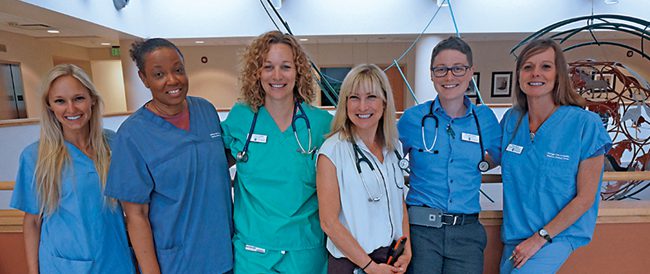 Read More
Read More

Drs. Katie Niksich (DVM ’07) and Carlo Riolo (DVM ’06) both graduated from the MSU College of Veterinary Medicine. Since then, the pair have become a force for change within the veterinary medical profession.
Niksich and Riolo founded PAW Health Network, Inc., a veterinary clinic in Mosinee, Wisconsin, built upon the wide range of the human-animal bond. Their model of the human-animal bond is a spectrum representing all the different relationships and strength levels of those relationships that exist between humans and animals.
Riolo describes the human-animal bond spectrum as if it were a standard bell curve. On the left are animals that play higher functional roles, such as production animals and animals that aren’t considered pets. On the other end are the fully anthropomorphized animals that are considered equal family members, often referred to as “fur babies.” Then, in the middle of the bond-spectrum, lie most animal owners.
Through their practice, Niksich and Riolo aim not only to address the importance of the human-animal bond, but also the role it plays in the lives of animals, veterinarians, veterinary team members, veterinary medical students, and animal owners. “The veterinary industry has not openly accepted the versatility in the human-animal bond, nor is there even a uniform acceptance within a single practice,” says Riolo. “This communication needs to begin by establishing a level of uniformity within the profession.”

Within the veterinary medical industry, each veterinary practice has aligned within a particular band of the bond spectrum. “Whether bond-aligning left or bond-aligning right, the clinic’s alignment drives the clinic’s culture. Anyone with clinical experience will agree that the alignment between members of the staff—and even between the caregivers—is not unanimous,” says Riolo. “This lack of bond uniformity results in animosity when individuals place their personal beliefs onto one another and try to force each other to believe their individual alignment. In the end, these differences affect the wellbeing of the team and create a clinic culture that negatively impacts our unified accountability to the patient.”
PAW Health aims to redefine the perspective on pet ownership and the veterinarian-patient-client relationship by taking a comprehensive and inclusive approach to veterinary healthcare. The practice was founded by creating a veterinary healthcare team with absolute equality between all members; it removed the traditional medical hierarchy. “We need to regain our collective accountability to the patient,” he continues, “and we have done that by unifying a team with individual responsibilities that supports the pet owner’s role within that team, which is why refer to pet owners as caregivers.”

The mission of PAW Health reflects the human-animal bond, and states that the animal is technically both the patient and the client. PAW Health treats these patients by educating their caregivers to maintain continuity of care throughout the patient’s life. At PAW Health, an acknowledged partnership between the practice and caregivers is at the root of the team’s ability to provide excellent care.
PAW Health’s goal is not to stress that the veterinary industry needs to choose one definition for the human-animal bond, but for it to acknowledge that the spectrum exists, and it effects the way future veterinarians are educated, how veterinary medical teams are created, and the level of care that is provided to patients and caregivers. When asked how he bond-aligns, Riolo responded by saying, “However the caregivers need me to align; I am just there to provide a service and support them in their decision, regardless of their attachment to the patient.”
By eliminating ongoing animosity (which results from neglecting the human-animal bond spectrum), PAW Health intends to reduce the amount of emotional, mental, and physical stress that is placed on the veterinary medical team. “We do not care who comes to our door,” says Riolo. “We are going to provide them with the same care options, same pricing, same coverage, regardless of the level of bond they share with their animal.”

Riolo warns that when veterinary healthcare teams cannot uniformly accept the differences in the human-animal bond, it further complicates when the financial bond spectrum, which signifies the relationship between income level and the human-animal relationship, is superimposed. For example, there are animal owners who love their pets more than anything, but they are unable to afford the cost of medical care (they bond-align high and financial-align low). This creates not only a great deal of stress for the animal owners, but also for the entire veterinary medical team, especially in a social media world.
“Our hope is to restore our accountability by acknowledging the importance of every role within that team and by mentoring veterinary medical professionals on the realities that the human-animal bond plays in everyday practice,” says Riolo.
“From day one, veterinary medical students feel pressure to be the apex for the chain—have all the answers, do everything, own practices, and manage staff and patients—but when does one person have enough time to do all that, let alone fix the current issues with clinic culture and bond alignment?” asks Riolo. “At the end of the day, there is not enough time for the veterinarian to do all that, and issues with clinic culture and bond alignment are ignored, and the same stress that results from this misalignment is present the next morning when they walk back into work.”
One avenue that Riolo and Niksich are using to combat this dynamic is to educate veterinary medical students through their mentorship program, “Student Success and Wellness for the Future of Veterinary Medicine.” The Program is funded by PAW Health Network’s Student Success and Wellness Fund. “We want to support students in the workplace by providing them with life skills they can carry into their professional lives,” says Riolo. “Everything we are doing is for the generations of veterinarians after us; it is our job as mentors to support those who come after us.”
















